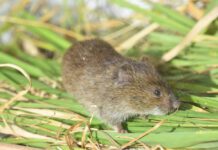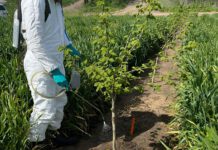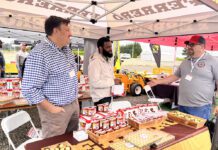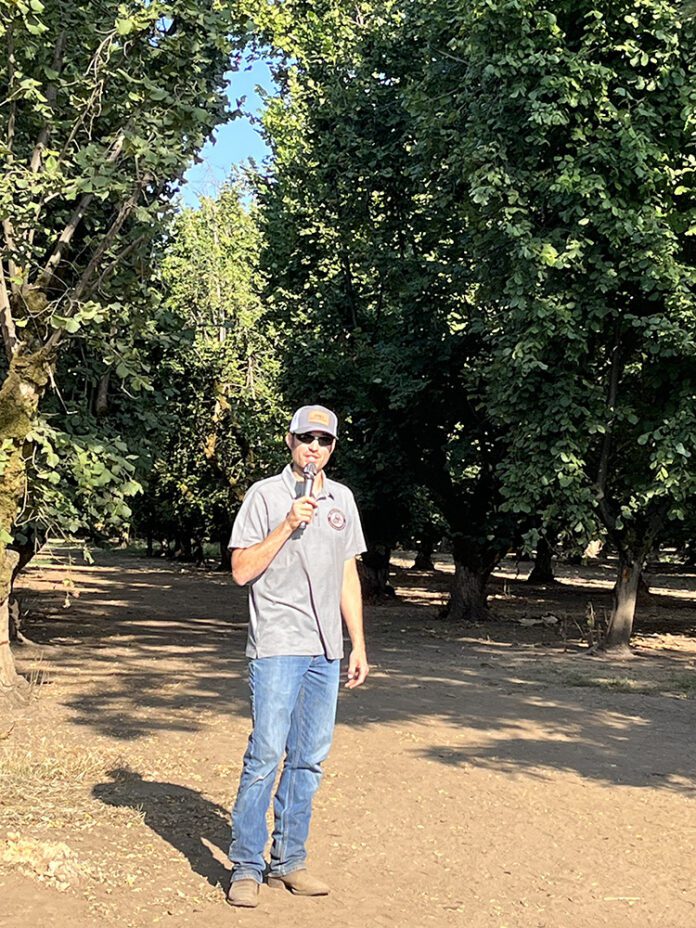
“People think I’m crazy,” said Matt Miller, whose family has farmed Miller Hazelnut Farms for five generations. The current president of the Nut Growers Society which promotes promoting nuts grown in Oregon, Washington and British Columbia, Miller said his innovative practices have changed the landscape of the farm’s 185 acres since his great-great grandfather staked a claim on the floor of the Willamette Valley.
More than 650 people who work in the hazelnut industry saw those changes first-hand during the Nut Growers Society Summer Tour August 7. Miller Farms was the one of the Tour’s four morning sessions.
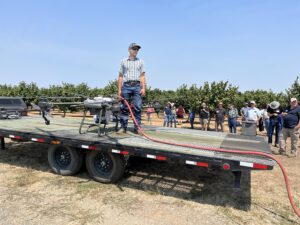
His grandparents’ oats, hops and livestock gave way to his father’s grass seed, and then hazelnuts. When Miller took over 12 years ago, he expanded orchards and began experimenting with techniques to reduce yield swings typical of hazelnuts, improve profits and promote tree health. He scrutinized hedging, pruning techniques, spraying technology, cover crops, soil health and sap analysis. As a result, his dryland farm is surviving the Eastern Filbert Blight, rising costs and the ups and downs of the markets.
There have been epic failures, Miller admitted, describing tiling problems, double-density hedging experiments and fertilization trials that left trees weak or unhealthy and unable to withstand weather disasters.
What has worked on the Miller farm? Among successful techniques are high and low hedging and pruning specific to the variety and the age of the grove, and grinding the tree materials into organic mulch that is returned to the soil. As a result, instead of adding nitrogen, his fertilization program focuses on micronutrients that vary depending on the results of sap analyses.
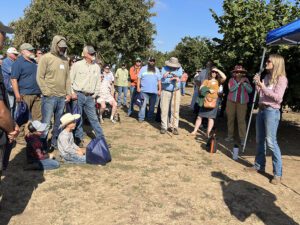
On display throughout the Tour were the tools and techniques used on Miller’s farm and on orchards throughout the West. More than 200 experts, trade vendors and sponsors staffed nearly 80 booths and displays, taught credit courses or staged demonstrations of the latest technology, services and science aimed at improving all aspects hazelnut operations, from financing to fertilization.
In a festive atmosphere that combined the elements of a family reunion and a county fair, society members and affiliates moved through the day’s events, asking questions of presenters, kicking machinery tires at the booths, catching up with friends and sharing their own hazelnut growing experiences.
“Growers were ecstatic to have the event back on the farm for the whole day, so hopefully we can do something similar next year,” said Colleen Nihen, executive director of the Hazelnut Industry Office. The Tour is one of several events the group sponsors throughout the year, including the Winter Meeting in January and regular networking called Catkins & Coffee. The society works in collaboration with the Hazelnut Marketing Board, Oregon Hazelnut Commission and other groups. Coming events are at members.oregonhazelnuts.org/.
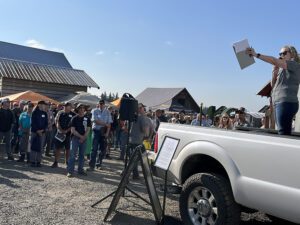
Spraying Takes Off
Heading up the “awesome” category was the drone sprayer demonstration by Timothy King, pilot for Precision Aerial Application. With onlookers holding their hats against the air and dust, the drone, about the size of a large man with his arms spread wide, lifted off the trailer toting about 10 gallons of spray. Although King can operate the drone’s specific movements on a tablet, this custom work to spray Miller’s youngest orchard, planted to PollyO in 2020, has been preloaded into the T-40’s memory. While the drone buzzed over the trees, dropping and spraying according to a specific plan, King answered questions about capacity and maintenance. Within 10 minutes, the drone returned to its perch on the flatbed to be reloaded before it flew back to where it left off to continue its work. Flying at about 9 feet above the treetops, this T-40 can spread liquid 30 feet wide and precisely cover approximately 15 acres of orchard per hour, delivering specific product according to the plant’s need.
That afternoon, equipment manufacturers also demonstrated new technology designed to reduce chemical use, airborne drift and run-off to optimize high-value crop yields and meet sustainability objectives.
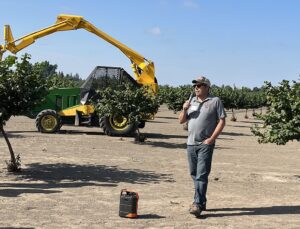
Double-Density Tips
In the cooler and quieter shade of the older hazelnut trees, two growers, Jason Perrott of Coburg, and Dan Keeley of St. Paul, talked about their various experiences with double-density planting, a method used to plant two varieties or denser rows during the first few years of a new orchard. The method to overplant younger trees is used to hedge bets against unpredictable circumstances (e.g., disease, weather and markets). But the method also acts as an orchard production contest among two or more varieties.
Miller said his was a cautionary tale. When he took over the farm, he failed to thin or properly hedge or prune a grove of his double-density trees until they were 17 years old, long after their canopies had grown together. After thinning, many of the trees were left weakened and some were uprooted by the heavy ice in the winter storm of 2021.
The lesson? “Don’t do nothing,” said Perrott.
Close observation in double-density trees is needed to determine which variety is best suited for the orchard. Doubling density can increase production for a few years, but eventually, the extra trees must be removed for the health of the remaining trees.
Despite the dip in production when the complementary trees are removed, Perrott warned, “You can’t be squeamish about taking them out. They have to go before they crowd and weaken the main variety.”
Barring disaster, interplanting a variety of trees was a good investment for him, Keeley said. He planted his McDonald trees in an equilateral triangle pattern, each tree the same distance from its neighbors, and used the smaller Yamhill as temporary trees. The upside to the honeycomb pattern is each tree has additional room to grow; the downside is the harvest row widths may not be uniform.
In addition to yield income, each grower must assess costs for interplanting, including removal of temporary trees, labor, mulching, fertilizer, spraying, sucker removal and other technology associated with double-density. Double-density doesn’t pencil out for everyone, Keeley said.
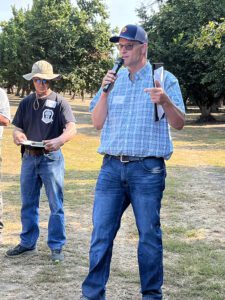
Pruning and Hedging
Nik Wiman, an orchard specialist for Oregon State University’s North Willamette Research and Extension Center, said rotational pruning, such as the methods used at Miller’s farm, can eliminate hazelnut’s biennial crop tendencies by opening the canopy to more light, promoting flowering and renewing fruiting wood.
Hand work is needed for young trees in the first three or four years to grow stronger trees that can withstand environmental challenges, such as snow and ice storms, Wiman said.
The goal in those first years is to develop three to five major scaffold limbs, beginning in the first dormant season. Scaffolds should radiate out from the tree’s crotch in all directions. The limbs should be evenly spaced, about 2+ inches separating them along the trunk, and all other shoots should be removed. Heading (removing a part of a branch) is used to promote branching structure, and thinning (removing an entire branch) is done to make corrections in the first years, following the grower’s plan for final height and width.
After five years or so, intensive hand work on young trees can turn to a mechanical and rotational hedging and pruning schedule depending on the cultivar, soil and factors peculiar to the farm. Increasingly, hazelnut growers are embracing mechanical hedging for some or all their annual pruning. Hedging and pruning are recommended for mature trees to reduce shade, promote accessibility and allow good spray coverage, Wiman said.
A detailed description of hazelnut pruning and hedging techniques is in OSU Extension’s 2023 catalog, publication 9078.
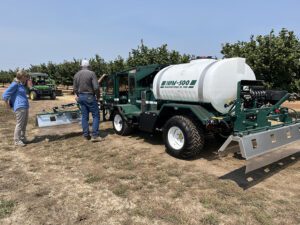
Soil Significance
At the USDA Natural Resources Conservation Service booth, Kameron Nicholson drops two similar-looking handfuls of soil aggregate into the top of two colanders filled with water. The handful of dry, clay-like soil common to the Willamette Valley quickly disintegrates and sinks. The aggregate with bits of grass and other organic matter disintegrates slowly, holding its shape after soaking for 10 minutes. Soils with structure are less susceptible to erosion and runoff, and are less likely to be lost to dust, Nicholson said.
In addition to keeping the soil where it is and adding structure, planting cover crops benefits the soil in other ways Dr. Shannon Cappellazzi told visitors in her morning session. Cappellazzi, Oregon Hazelnut Commission researcher, is former manager of OSU’s Central Analytical Laboratory and Soil Health Institute’s lead scientist for the North American Project to Evaluate Soil Health Measurements. The roots of cover crops dig into the soil, providing nitrogen and organic nutrients that they share with the trees, reducing costs for fertilizer and other chemicals. The living cover crop also keeps the soil temperature lower in the summer, reducing evaporation and increasing soil moisture.
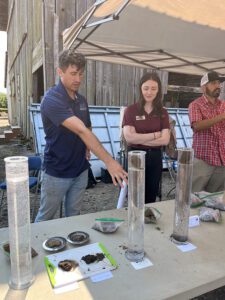
The perfect cover crop will work for the grower’s specific needs and goals, such as reducing costs for water, fertilizer and labor, Cappellazzi said. Before planting a cover crop, growers should consider which species won’t interfere with harvest practices, the site’s soil type and slope, the best species for weather conditions, whether perennial or annual species work best for the site and the equipment needed to manage the system.
“There’s not a single fit for everyone,” Cappellazzi said.
In addition to the demonstrations and presentations, the Tour included Oregon Department of Agriculture Pesticide Credit Courses for attendees who wanted to earn credits toward their pesticide license. Best Practices for Airblast Applications in Hazelnut Orchards was taught by Wiman, and Fungicide Refresher for EFB Management was taught by Jay Pscheidt, of OSU Extension.







